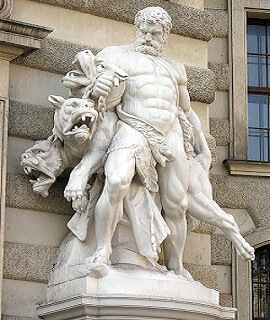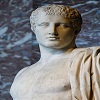Hades
King of the Underworld
Hades was both the name of the ancient Greek god of the underworld (Roman name: Pluto) and the name of the shadowy place below the earth which was considered the final destination for the souls of the dead. Perhaps the most feared of the gods, he is described by both Homer and Hesiod as "pitiless", "loathsome", and "monstrous" Hades.
HADES THE GOD
Following the overthrow of first the Titans and then the Giants by the Olympian gods, Hades drew lots with his brothers Zeus and Poseidon to decide which part of the world each would rule. Zeus received the sky, Poseidon the seas, and Hades the underworld. Perhaps a less prominent protagonist in the tales of mythology than the other Olympian gods, Hades, nevertheless, must have been held in superstitious awe by many ordinary Greeks.
Indeed, even to speak his name was avoided; instead epithets were used such as Eubuleus (giving good advice). There are also accounts of sacrificial practices made in honour of Hades, carried out at night and where the blood of victims was left to seep down into the earth to reach the underworld god.
In mythology, Hades fell in love with Persephone, daughter of Zeus and Demeter, and abducted her to live with him. When Hermes discovered this, he demanded Persephone be returned to Demeter and it was decided that if she had not eaten any food from Hades, she could return to the upper world. However, Hades tricked the girl into eating a pomegranate seed and therefore she could only return to the living for half of the year.
This myth was symbolic perhaps of the cycle of life and death, planting and harvest. The celebration of Persephone's return to the upper world was probably a part of the famous Eleusian Mysteries performed at the sanctuary of Demeter at Eleusis.
In Archaic and Classical Greek art, Hades is most often represented as a more mature man, bearded and holding a sceptre, a two-pronged spear, a libation vase, or a cornucopia - symbolic of the mineral and vegetable wealth which comes from the ground. On occasion he is seated on an ebony throne or rides a chariot pulled by black horses, often with Persephone at his side.
Hades and the Underworld
The god Hermes was believed to lead souls to the river Styx in the underworld, at which point the aged boatman Charon ferried them to the gates of Hades where Kerberos - the ferocious three-headed dog (or fifty-headed according to Hesiod) with serpents coming out of its body - stood guard to keep souls in rather than to keep others out. It was for payment to Charon that bereaved family members put a coin in the mouth of the deceased (for Greeks the traditional coin was the low-value obol).
The unburied or those without the means to pay the boatman were condemned to wander the Earth as ghosts. This belief hints at the ambiguous nature of Hades. It was not necessarily a place of torment and suffering but in most cases, simply the final resting place of the soul.
On arrival at the gates of Hades, the final destination of the souls was determined by an assessment of their actions whilst they were alive. Traditionally, the three judges of souls were Minos, Rhadamanthys, and Aiakos, themselves noted for their honourable lives. Souls judged to have led especially good lives were first taken to drink the waters of the River Lethe which made them forget all bad things, and then they were taken to the idyllic Elysian Fields.
Those souls judged to have led bad lives were put in the hands of the Furies and taken to Tartarus, the lowest level of Hades, to receive punishment for their misdeeds. The worst-offending souls, those who had offended the gods with their impiety, were condemned to eternal torment. Examples of those so punished were Sisyphos who had to forever roll a rock up a hill, Tantalos who could never quench his thirst, Oknos who plaits one end of a rope while a donkey eats the other end, the daughters of Danaus who had to try and fill a sieve with water, and Ixion who was tied to an ever-spinning wheel.
Although a fearful place to the living, Hades was visited by several heroes in the course of their various adventures, including Hercules to capture Kerberos in the last of his twelve labours, by Odysseus to seek the advice of wise Tiresias, by Orpheus to find Eurydice, and by Theseus and Peirithoos to capture Persephone so that she might marry the latter. These last two heroes were, however, less fortunate than the others in that Hades imprisoned them in two thrones (or tied to two rocks in other accounts) and only Theseus would later escape from the underworld when Hercules released him.
Also:
Hades was the only god not to reside on Mount Olympus, dwelling instead in a dark palace beneath the earth. The god also had a helmet made by Hephaistos which rendered the wearer invisible, and it was this helmet that was used by Athena when she fought Ares in Homer's account of the Trojan War in the Iliad and by Perseus in his quest for the head of Medusa.
He is the King of the dead but, death itself is another god, Thanatos.
[1]
Hades and Persephone: the beginning of the myth
Hades fell in love with Persephone and decided to kidnap her. The myth says that in one of the rare times he left the Underworld, he traveled above ground to pursue her, while she was gathering flowers in a field.
A different version of the myth of Hades and Persephone
The myth of Hades and Persephone also has a different version; in this one Demeter was present when Persephone was kidnapped by God Hades but was tricked by Zeus and Hades.
That morning when Demeter descended on Earth with her daughter Persephone , she left her to play with the sea nymphs called Nereids and the Naiads who were the freshwater nymphs of the lakes, springs and rivers.
Persephone and flower Narcissus
Demeter went to supervise her bountiful crops. As Persephone engaged in play and with the rest of the group, her attention fell upon the potently fragrant valley nearby and she couldn’t take her eyes of the yellow flower narcissus. She called upon her playmates to accompany her, but they couldn’t possibly go with her as leaving the side of their water bodies would result in their death.
The flower Narcissus was planted there by Gaia, who was following the orders of Zeus. The goal was to enchant Persephone and attract her, away from her guides.
So, Persephone danced her way to the garden alone and tried to pluck the narcissus from the bosom of Gaia. It drained her energies as the narcissus only came out after a lot of pulling. But suddenly, to her utter fright, she saw the tiny hole from which she had drawn out the flower shaft, began to rapid grow in size until it started to resemble a mighty enormous chasm.
Hades Kidnapping Persephone
From this came the vigorous galloping sounds of multiple horses and such sudden happenings only froze the frail beauty to her feet. Out of all her friends only the naiad Cyane tried to rescue the crying Persephone but she was no match for the powerful Hades. Bereaving her friend’s kidnap, Cyane melted into a pool of tears and formed the river Cyane at the spot.
Goddess Demeter trying to find Persephone
Demeter rushed back to where she had left her daughter and found only the Cyane river there with the other nymphs weeping. Worried as she was, she asked all as to the whereabouts of her beloved daughter.
Nobody could tell her anything at all and furious that they couldn’t protect her child, she cursed all the nymphs into becoming heinous women with plumed bodies and scaly feet, called the sirens. It was only the river Cyane who helped her by washing over the belt of Persephone, indicating that something gravely wrong had happened.
Demeter went mad and hunted for her daughter everywhere. The myth says that she even disguised herself as an aged lady and with lighted torched in her hands roamed the Earth for nine long days and nine long nights.
Finally, she met Hekate, the deity of magic, witchcraft, spirits and crossroads, at the dawn of the 10th day who had pity at her dismal condition and asked her to seek help from the all seeing Helios, the sun god. Helios told Demeter all about how Hades had dragged Persephone into the underworld.
Persephone in the Underworld
Persephone's mother, Demeter, begged her brother Hades to allow Persephone to come back to the livings, denoting that the young Persephone was not supposed to live in the underworld. Hades consulted with Zeus and they both decided to allow Persephone to live on earth for six months each year, while the rest of the time she would be on his side in the Underworld.
Before leaving the underworld, Persephone had been persuaded to eat four seeds of a pomegranate. In ancient mythology, to eat the fruit of one’s captor meant that one would have to return to that captor or country, so Persephone was doomed to return to the underworld for four months of the year. But she was allowed to spend the remaining two-thirds of the year with her Earth Mother, Demeter.
The myth of Hades and Persephone is associated with the coming of Spring and Winter: When Persephone comes to the Earth, it’s springtime. When she descends to Hades, it is winter.
Celebrating the myth of Persephone
The disappearance and the return of Persephone were the occasions of great festivals in ancient Greece, among them the Elefsinian rites, whose secrets were so closely guarded that little is known about them today.
Some experts believe the rites or mysteries fostered the idea of a more perfect life after death, and thus helped to lay the groundwork for the coming of Christianity, which upholds the idea of everlasting life.
[2]
Facts about Hades
Hades is best known as the ruler of the underworld. It became his dominion after he and his brothers drew lots for their share of the universe.
According to Iliad, Hades’ dominion lies between secret places of the earth. According to the Odyssey, one must cross Ocean to get there.
Though Hades supervised the dead assigned to his realm, he was not one of its judges. Three demi-gods served that purpose instead.
Hades was depicted as stern and unyielding, unmoved by prayer and sacrifice.
Hades had a cap or helmet that made its wearer invisible.
His wife was Persephone, Demeter’s only daughter, whom he kidnapped and made his queen.
He was also called the God of Wealth or “the rich one” because he possessed the precious metals of the earth.
Pirithoüs, friend of Theseus, detrmined to have Persephone (the most carefully guarded lady in all the universe) as his bride. To this end, the two friends journeyed to the underworld, but Hades thwarted their plan. He invited them to sit on the Chair of Forgetfulness, which cause its occupant to forget everything. Hercules rescued Theseus, but the King of the Dead held Pirithoüs there for trying to steal his queen.
Cerberus was a three-headed dog who guarded his realm; the ferryman Charon was another one of the underworld’s attendees.
Though Hades is the King of the Dead, he should not be confused with Death itself, which is personified by Thanatos.
Cronus and Rhea were his parents.
Poseidon and Zeus were his brothers.
Hades rarely left the underworld. His presence was not welcomed by men or by gods.
Hades took pride in collecting “subjects” for his kingdom and was disinclined to let anyone leave.
His dominion was separated from the land of the living by the following rivers: Styx, Lethe, Acheron, Phlegethon, and Cocytus.
Hades employed the Furies, who were responsible for torturing the guilty.
Hades is described by some sources as the god of the earth’s fertility.
The narcissus and the cypress are sacred to him.
In his kingdom, Hades sat on a throne made of ebony and carried a scepter.
Hades was known for his involvement with Sisyphus, the man condemned to the underworld to forever roll a boulder uphill. According to legend, Hades allowed Sisyphus to return to earth long enough to arrange his own funeral.
[3]












